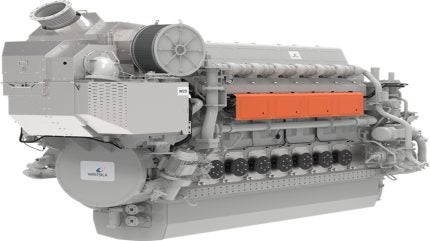
Finnish technology provider Wärtsilä has launched its NextDF technology for its Wärtsilä 25DF dual-fuel engine, with an aim to lower methane emissions from ships.
This feature ensures that methane emissions are kept below 2% of fuel use across all load points, with figures as low as 1.1% within a broad load range.
The technology also contributes to lower nitrogen oxide (NOx) emissions than the standard Wärtsilä 25DF engine, which already complies with IMO Tier III standards.
The introduction of NextDF technology comes at a pivotal time as the shipping industry seeks to bridge the transition from traditional diesel fuels to carbon-neutral alternatives.
LNG, the main component of which is methane, is a crucial transitional fuel. However, incomplete combustion can lead to methane slip, a potent greenhouse gas.
Wärtsilä’s NextDF technology addresses this issue, offering an immediate solution to reduce greenhouse gas (GHG) emissions from marine engines over the next decade, alongside CO2 reduction efforts.
How well do you really know your competitors?
Access the most comprehensive Company Profiles on the market, powered by GlobalData. Save hours of research. Gain competitive edge.

Thank you!
Your download email will arrive shortly
Not ready to buy yet? Download a free sample
We are confident about the unique quality of our Company Profiles. However, we want you to make the most beneficial decision for your business, so we offer a free sample that you can download by submitting the below form
By GlobalDataInternational and regional regulations are increasingly focusing on methane emissions.
The International Maritime Organisation (IMO) is considering methane in its forthcoming GHG regulations, while the EU is set to implement methane-related measures in FuelEU Maritime from 2025 and in the EU Emission Trading System (EU ETS) from 2026.
Under EU rules, engines not certified with lower emissions will need to comply with a default methane emission rate of 3.1% of fuel use.
Wärtsilä Marine Power Supply vice president Stefan Nysjö said: “Enhancing dual fuel technology to further reduce methane emissions will have a major impact on the long-term viability of LNG as a marine fuel.
“Our work around reducing methane slip and GHG emissions is part of Wärtsilä’s effort to continuously improve efficiency and reduce emissions of our products. This innovation is one more very important step along the road to decarbonisation.”
The FuelEU Maritime regulation will introduce a system that penalises non-compliance while rewarding overcompliance through banking or pooling of compliance surpluses.
This regulatory framework aims to incentivise the adoption of technologies like NextDF that can reduce GHG intensity.
Launched in 2022, the Wärtsilä 25 engine platform is designed to be modular and upgradeable, allowing for significant reductions in fuel consumption and emissions.
“The Wärtsilä 25DF engine has already set an industry benchmark for low methane slip, down to as low as 1.4% at certain load points. By making available our NextDF technology for the Wärtsilä 25DF engine enables operators to go even further in reducing methane emissions.
“This increases overcompliance with EU regulations, therefore offering tangible financial benefits for shipping operators, whilst simultaneously helping them to futureproof their vessels in the longer term,” added Stefan.
The NextDF technology enhances engine efficiency by up to 0.5% percentage points. Following its introduction on the Wärtsilä 31DF engine in 2023, the technology is now also available for the Wärtsilä 25DF engine, with retrofitting options for existing engines.
Deliveries of the Wärtsilä 25DF engine equipped with NextDF are expected to commence in the second half of 2025.



